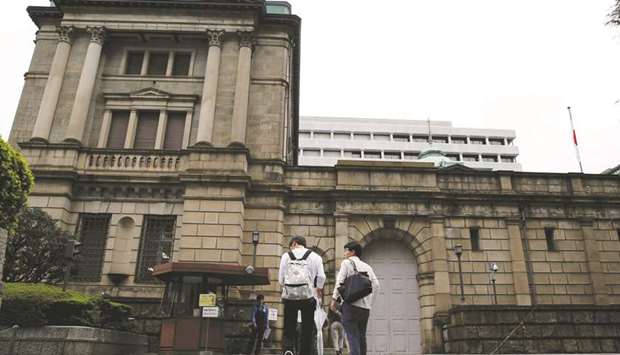The central bank held a fixed-rate operation to cap the 10-year yield last Friday when it climbed to a five-month high. It decided against conducting a similar operation for the five year on Monday when the yield rose to the highest since January 2016.
Instead it edged up the volume of its regular bond purchases – though still keeping them within its planned range for the month.
With the BoJ’s tussle to control a finely-tuned bond market now being measured in tenths of a basis point, investors are parsing every operation to divine meaning.
The fact it allowed the five-year yield to rise past the level where it intervened in November has bolstered the view the BoJ is becoming more tolerant of increases for shorter maturities.
“The central bank recently seems to have become a bit more flexible,” said Akio Kato, general manager of trading at Mitsubishi UFJ Kokusai Asset Management Co in Tokyo.
“What the BoJ must defend is the 10-year and the overnight call rate, so its resolve to cap the five-year yield around minus 0.04% seems weaker relative to that for the 10 year.”
Under its yield-curve control policy adopted in September, the BoJ aims to keep the 10-year bond yield around zero to foster an economic recovery.
It has held three operations to buy an unlimited number of bonds at a fixed rate to cap yields: the first for two-to-five year debt in November, the second for 5- to-10 years in February, and the third for 5-to-10 years last Friday.
In last week’s operation it offered to buy the 10-year benchmark at 0.11%.
The benchmark 10-year bond was little changed on Friday at 0.075%, and the five-year was at minus 0.05% in Tokyo.
Bond market participants told the BoJ at meetings last month it should consider a policy framework that allows greater volatility in bond yields, while interest rates are maintained at a sufficiently low level.
Members of the Bond Market Group – which include brokers, banks and investors – also said the BoJ doesn’t necessarily need to suppress price fluctuations.
The five-year yield climbed from its 2017 low of minus 0.175% in April to as high as minus 0.035% on Monday.
That saw the spread with the 10-year shrink to just above 10 basis points last week, the narrowest since December, fuelling speculation the benchmark will be pushed above the 0.11% level the BoJ identified as a line in the sand last week.
Kato at Mitsubishi UFJ Kokusai Asset Management: “By firmly pinning 10-year yields, there will be a limit to how high the five-year yield may rise as it’s unlikely for the five-year to match the 10-year yield level. The five-year cap is likely around zero”.
Eiichiro Miura, chief portfolio manager at Nissay Asset Management Corp in Tokyo: “Five-year yields can rise toward zero if that’s in line with economic fundamentals. “Inflation is stable but the economy is improving, so I don’t think the BoJ feels uncomfortable about yields rising outside its control areas. Buyers are likely to emerge when yields rise, and it’s quite a different story if it turns positive”.
Naomi Muguruma, a senior market economist at Mitsubishi UFJ Morgan Stanley Securities Co in Tokyo: “The five-year yield around minus 0.035% isn’t particularly unusual given that the overnight call is at minus 0.1% and the 10-year yield target is around zero”.
“Whether it becomes an issue or not depends on what drives the five-year yield closer to zero, and what will happen after it approaches zero, but there are likely to be investors buying at that level, so the situation is a bit different from 10 years”. “If the five-year rises past zero, that would push up 10-year yields, so the BoJ will step in”.

